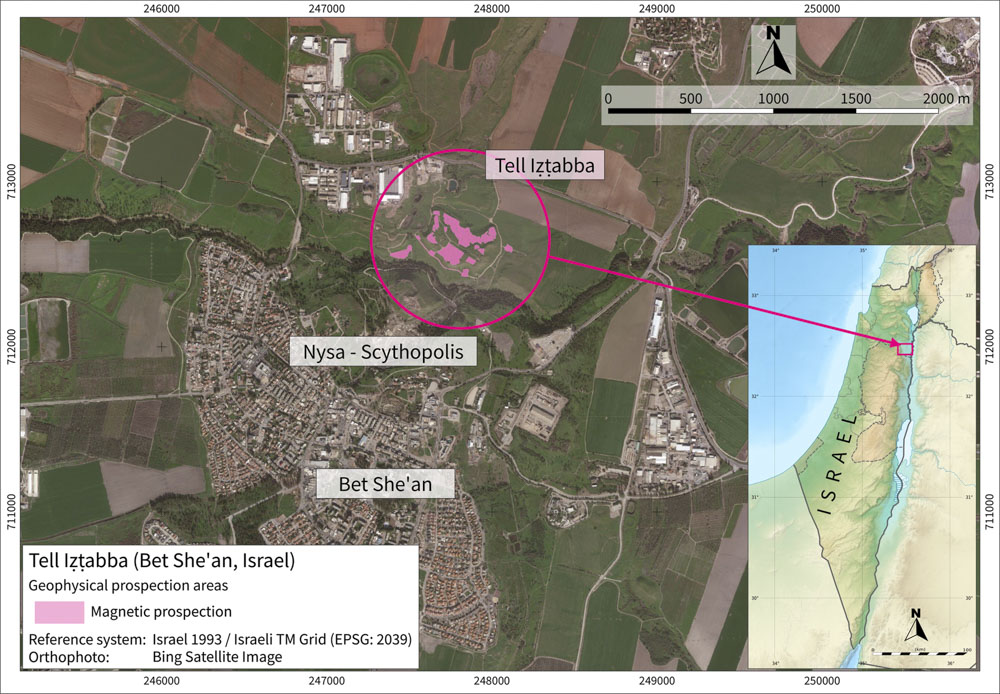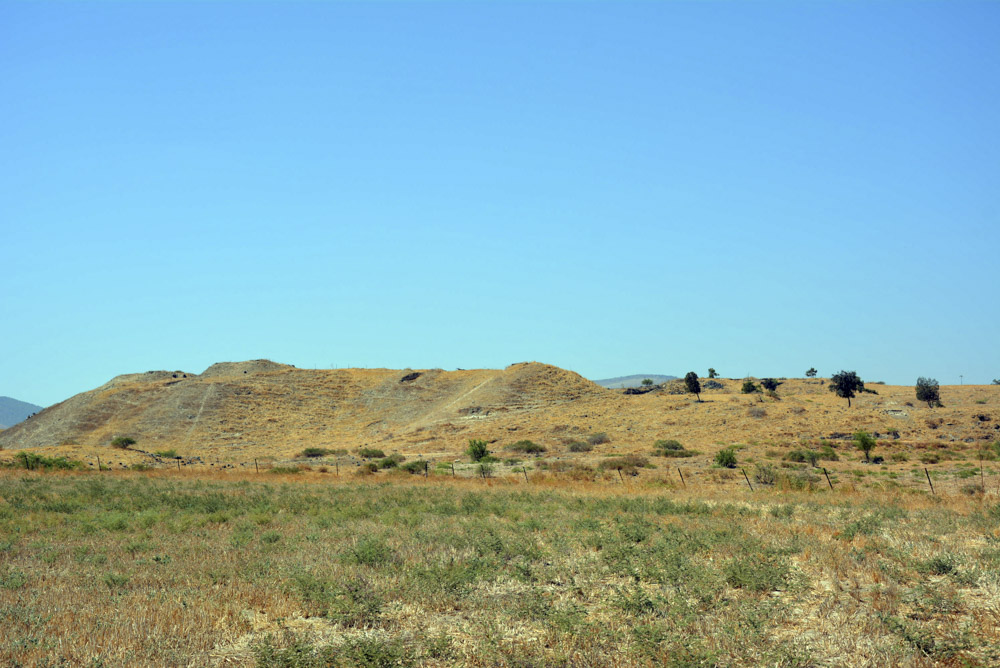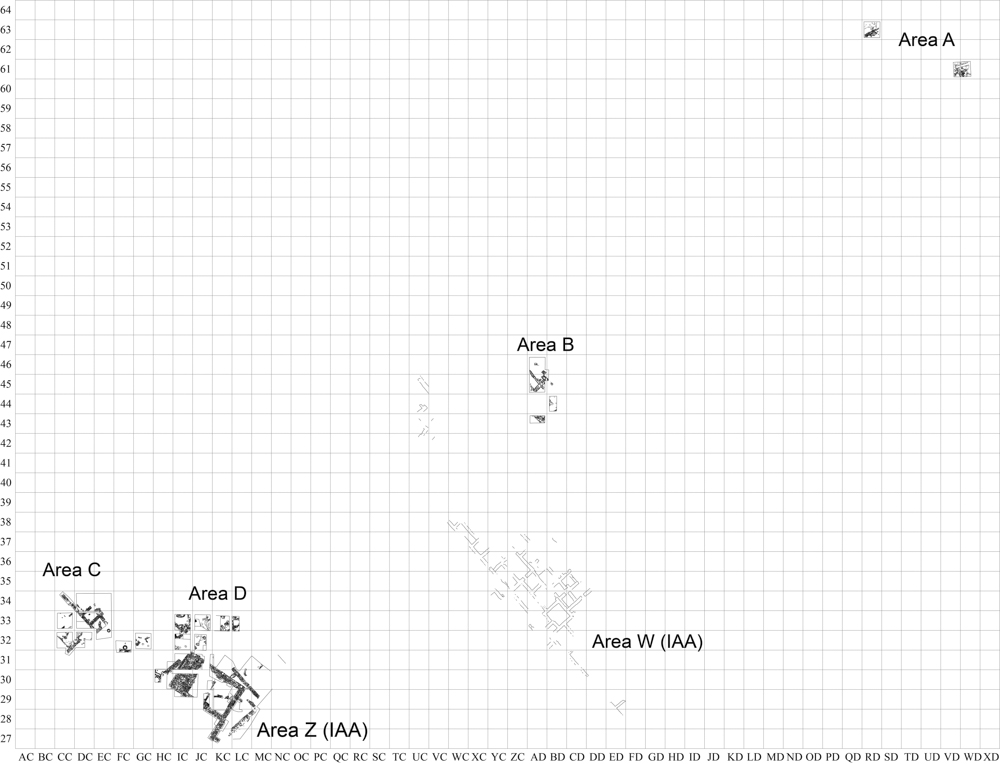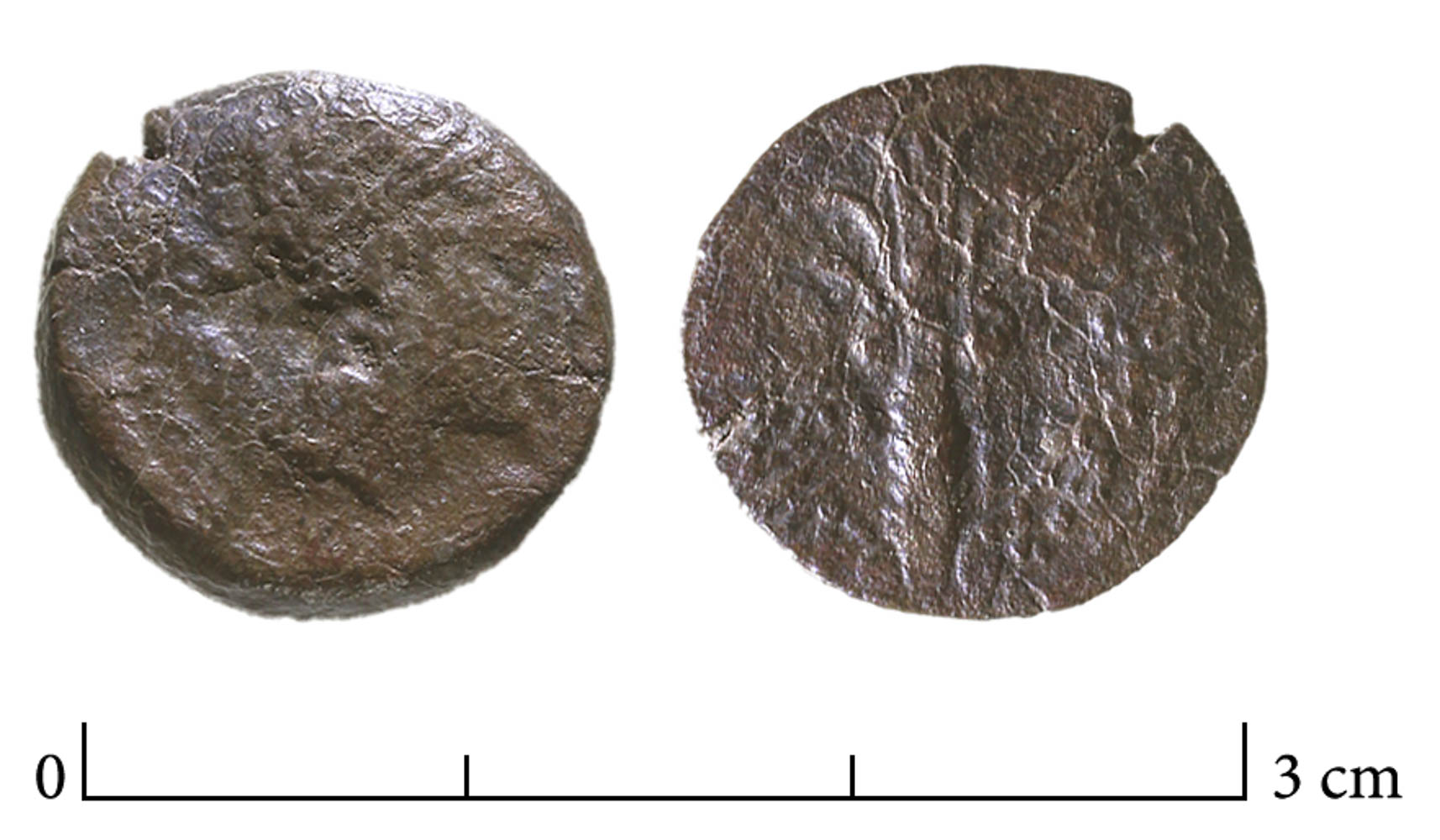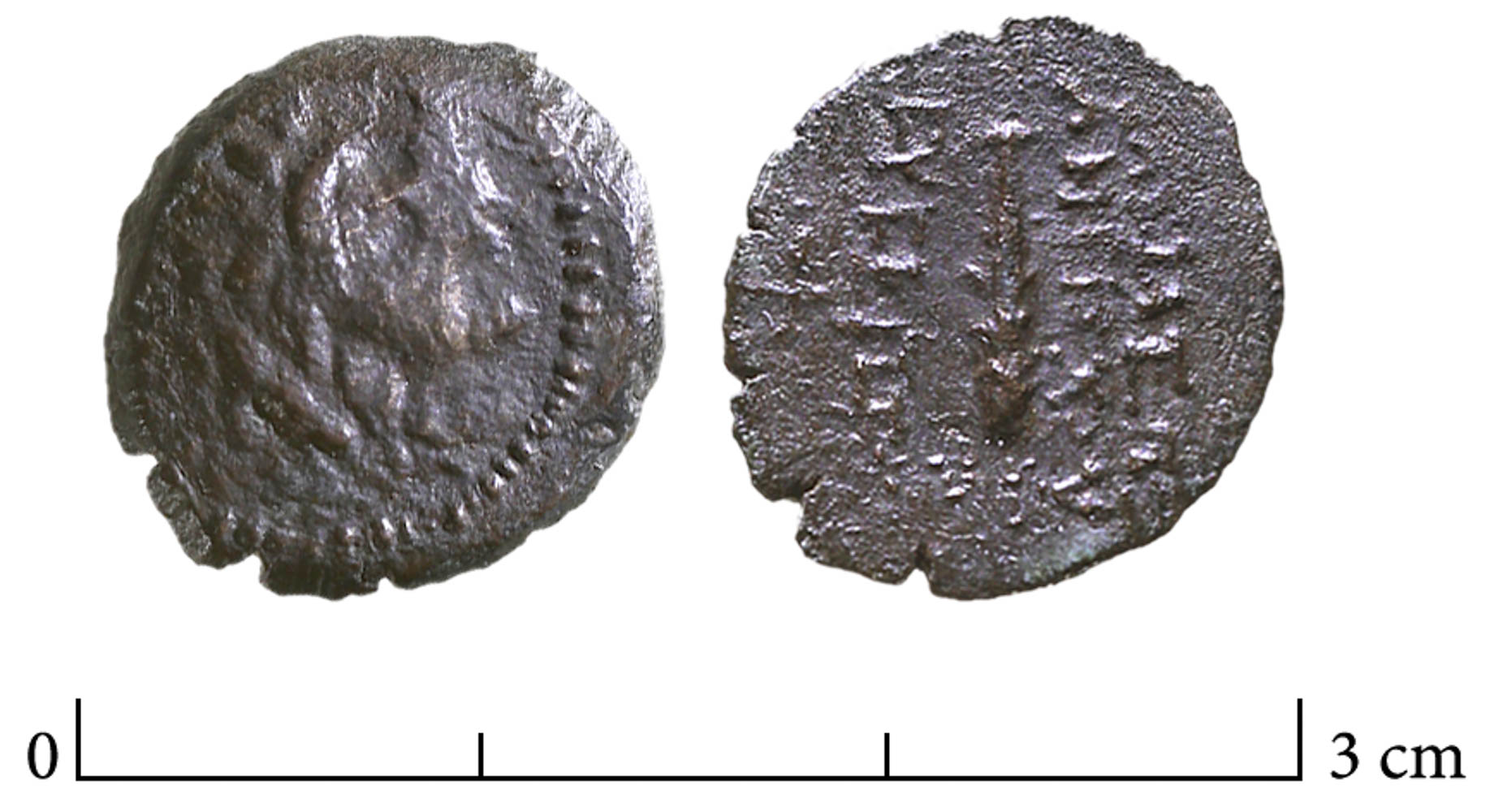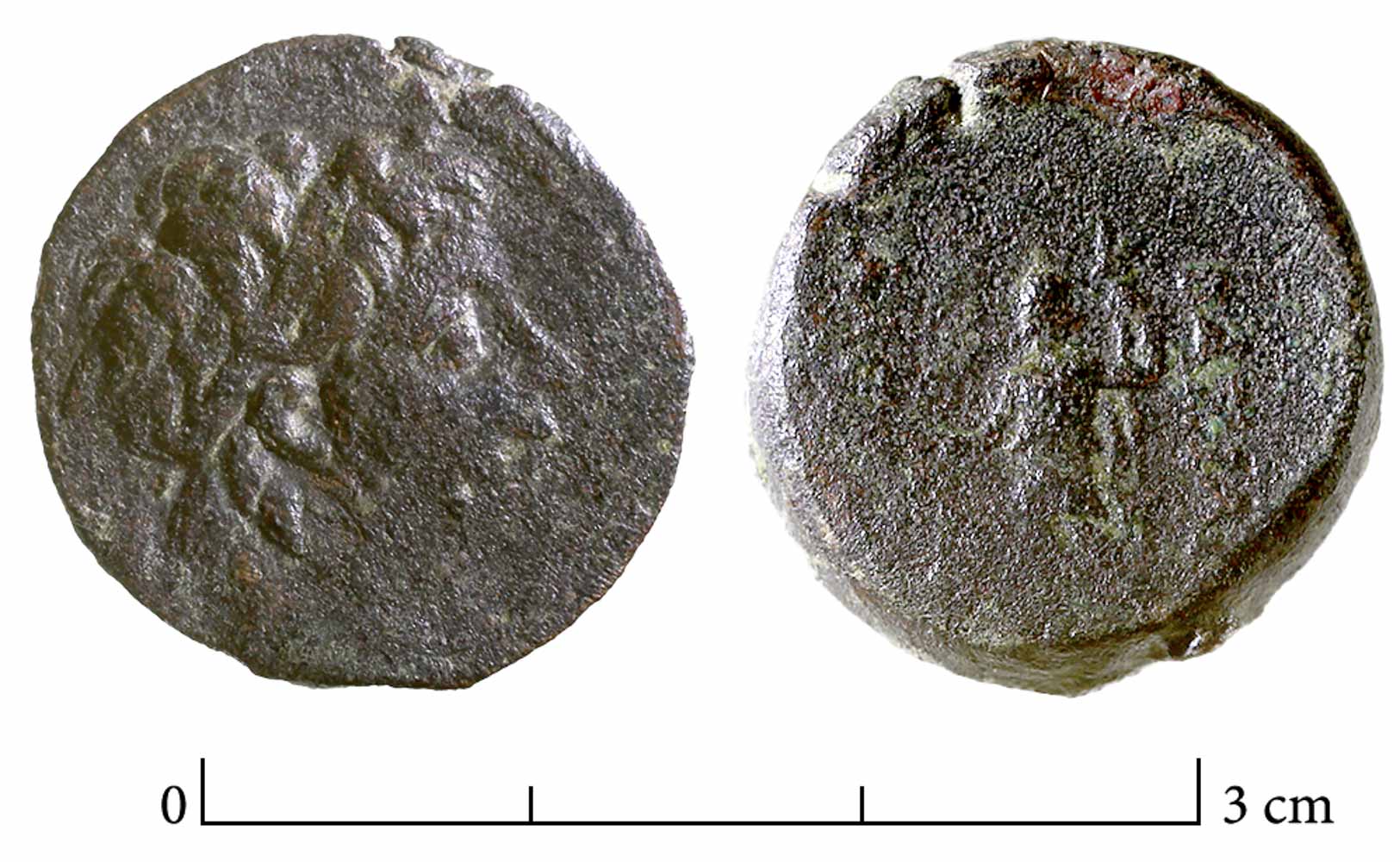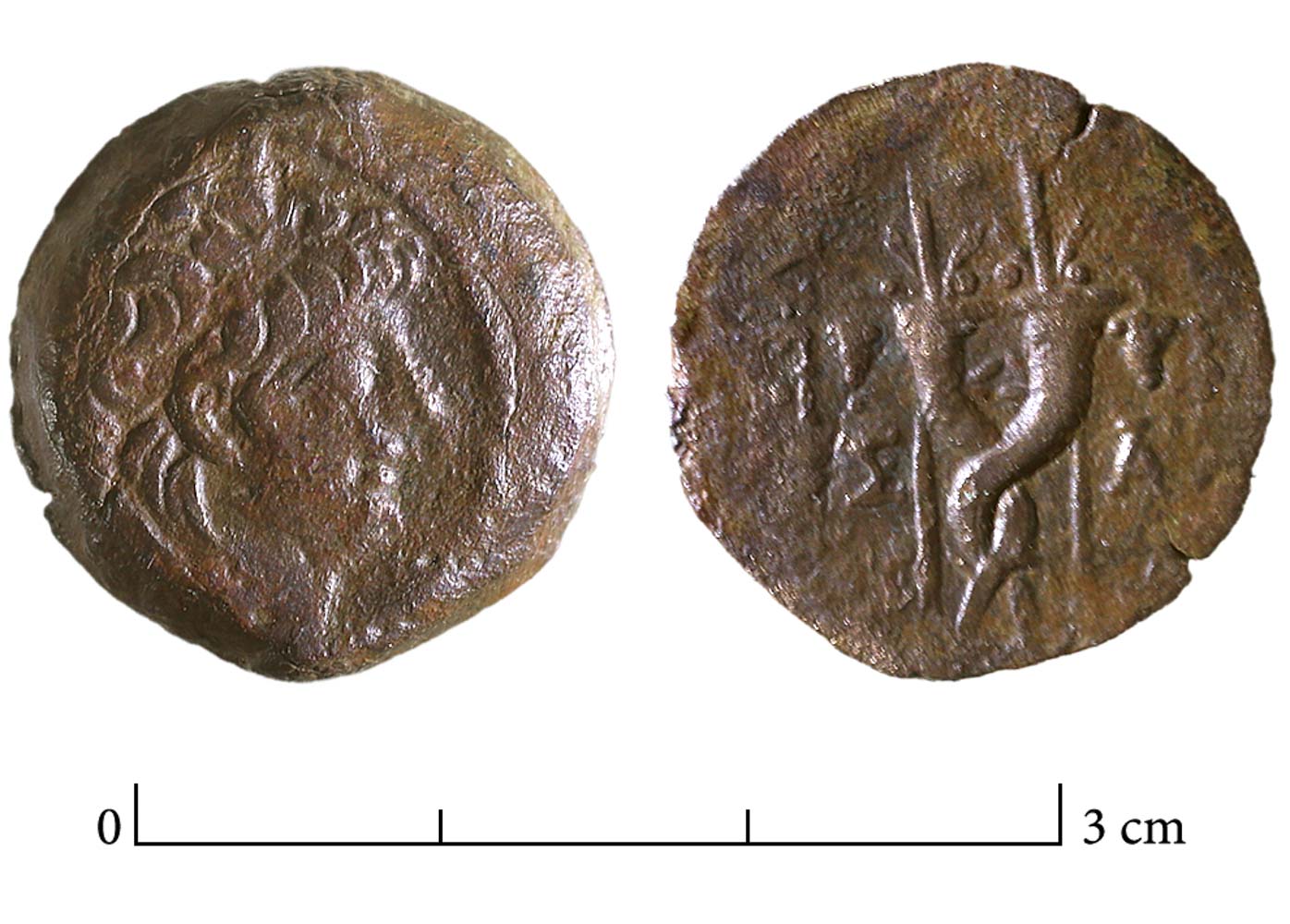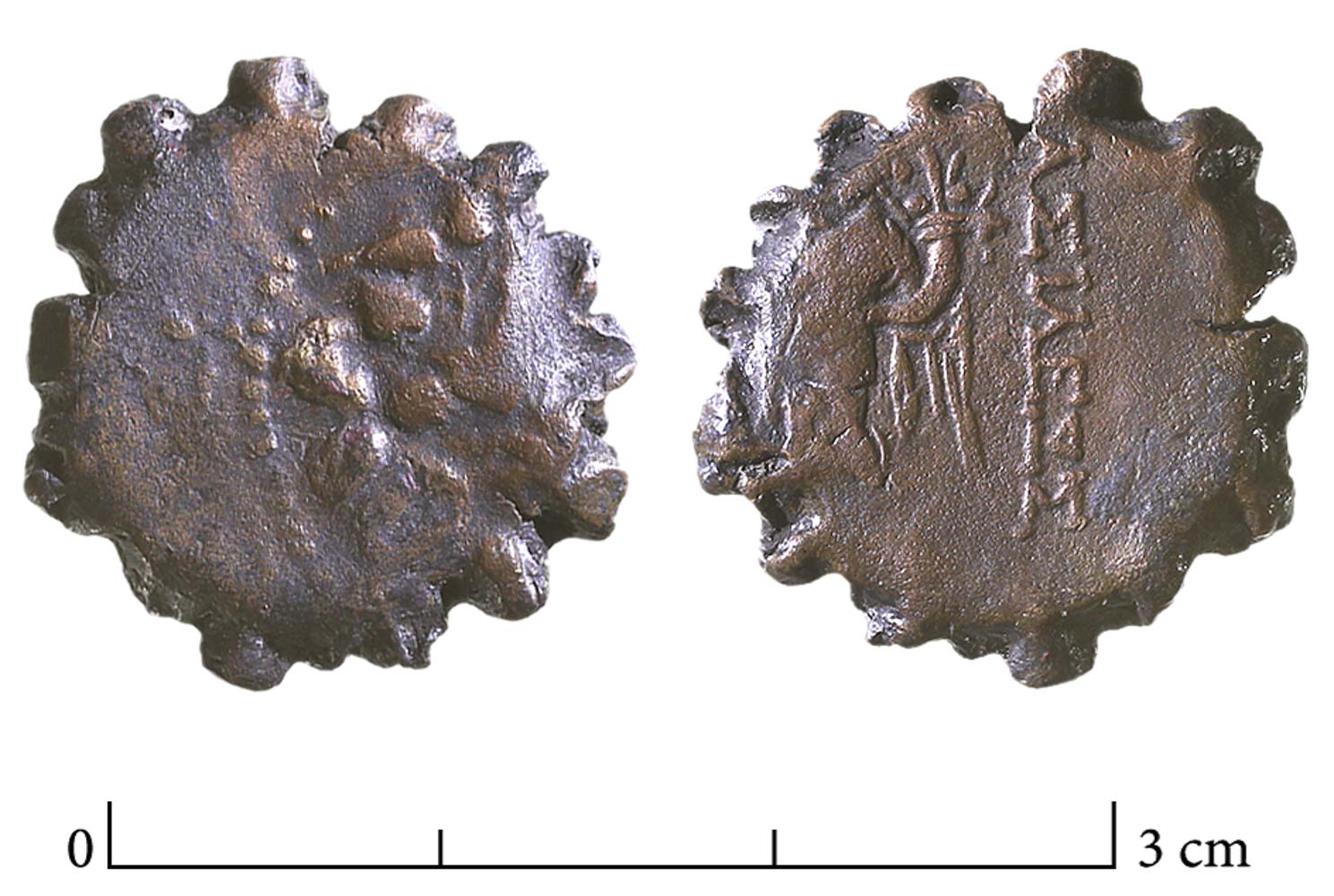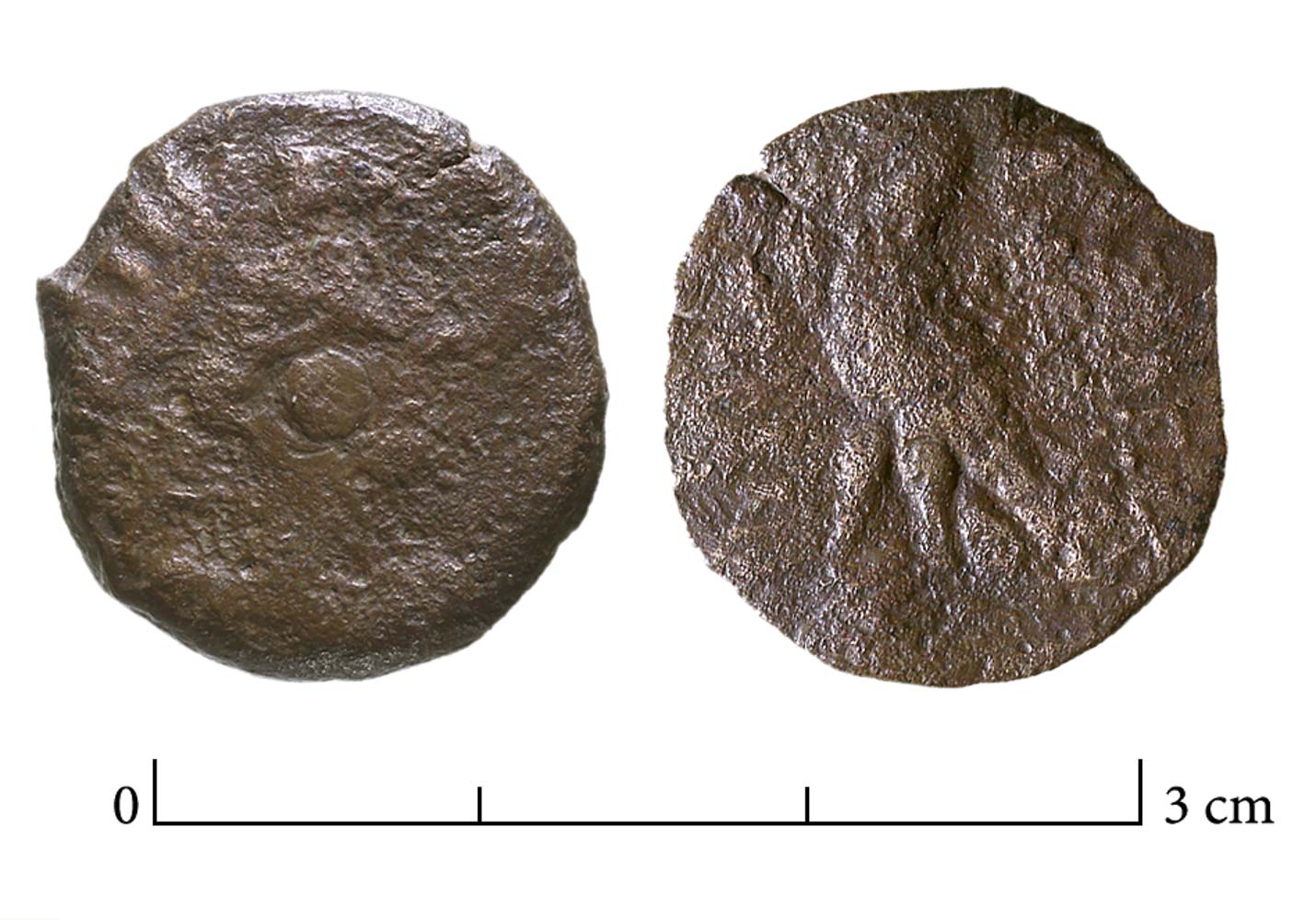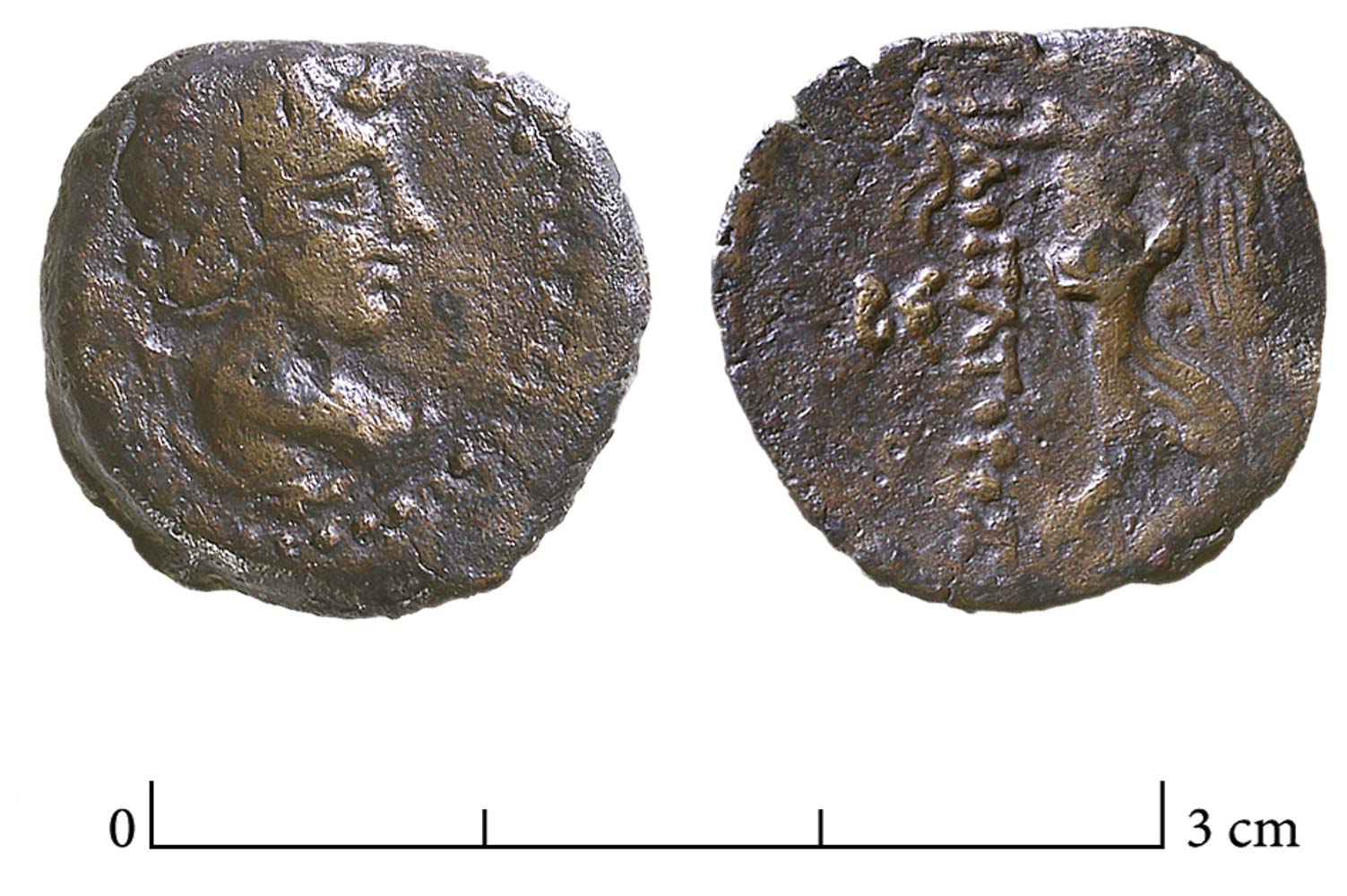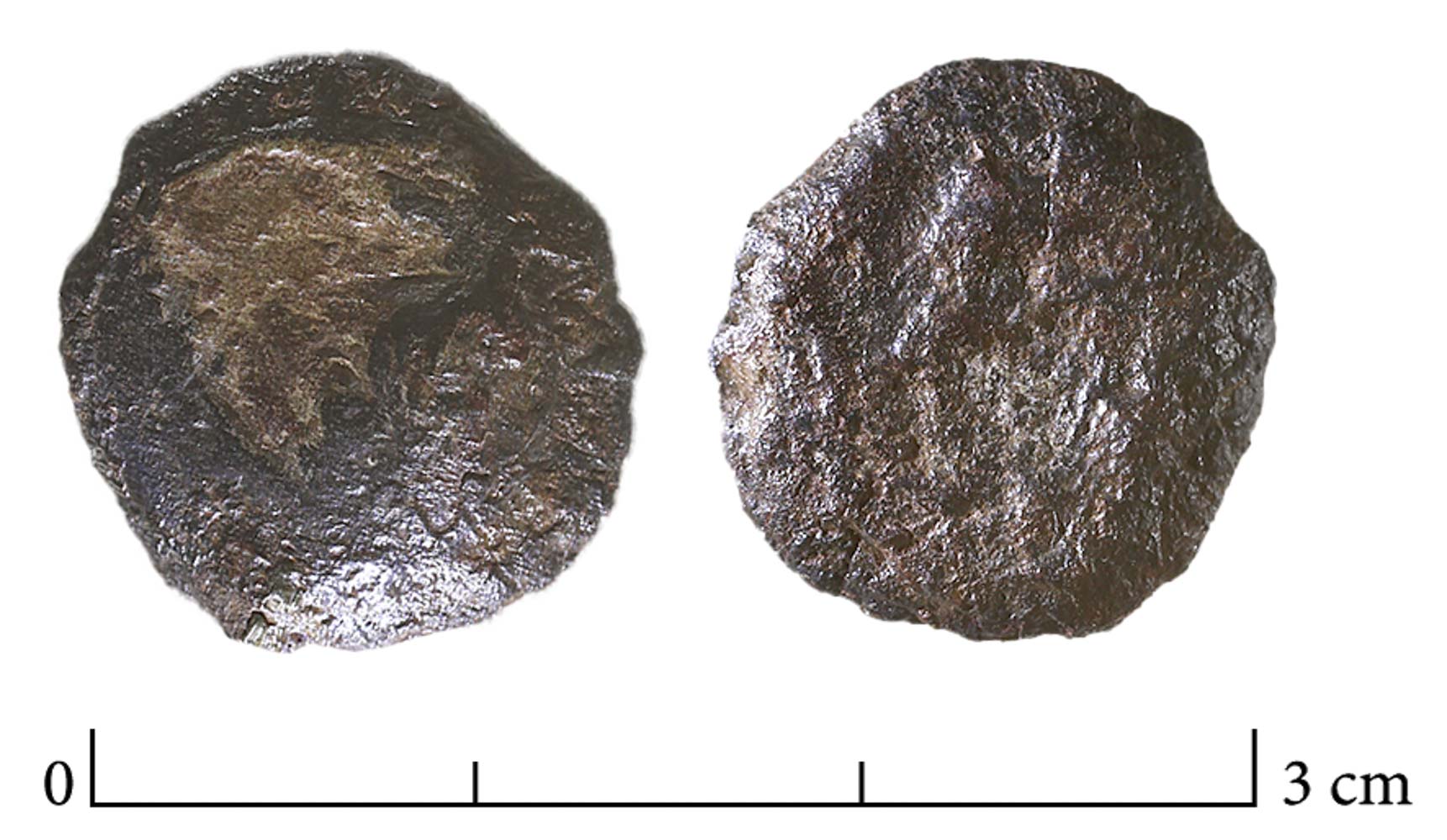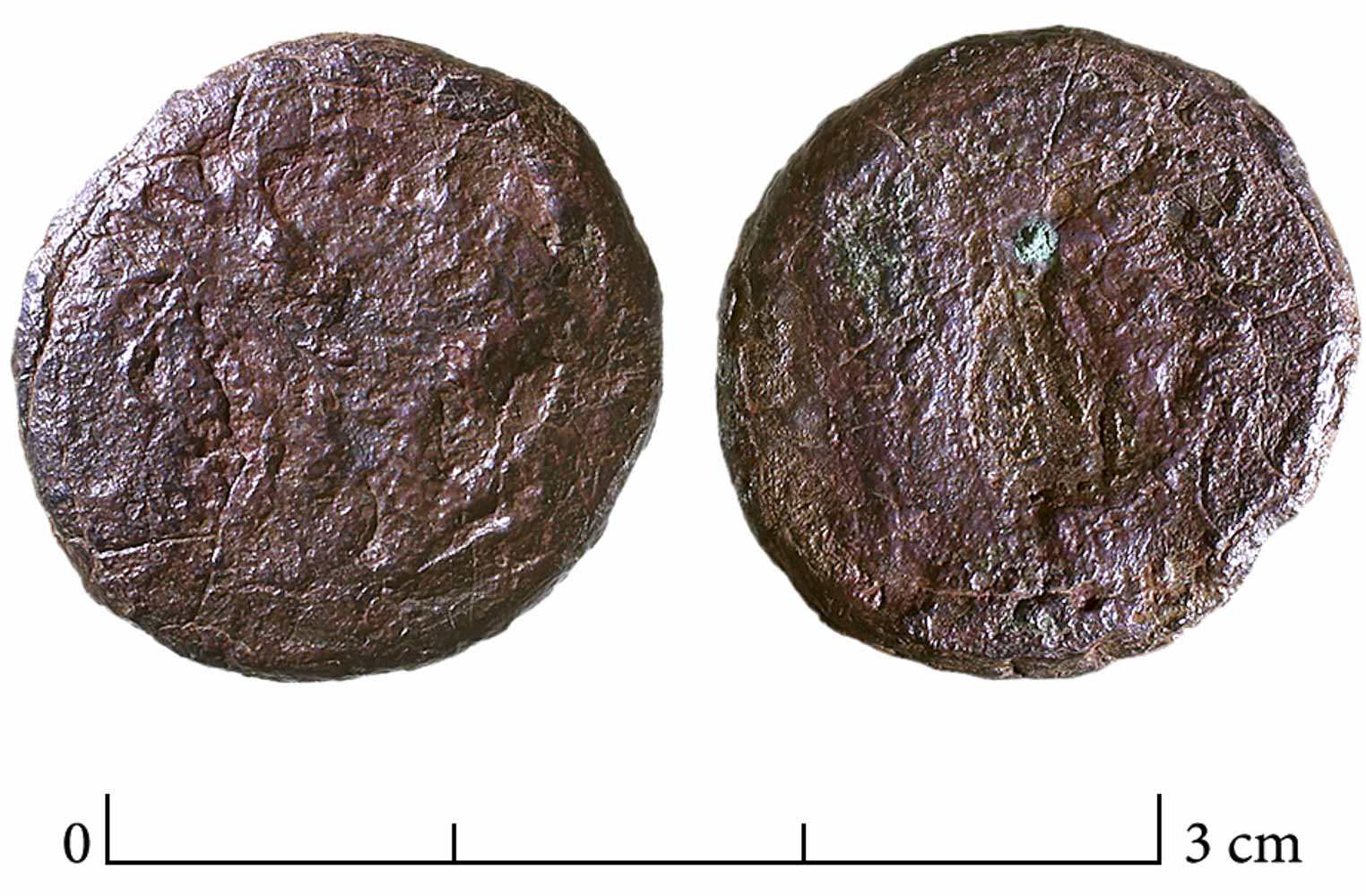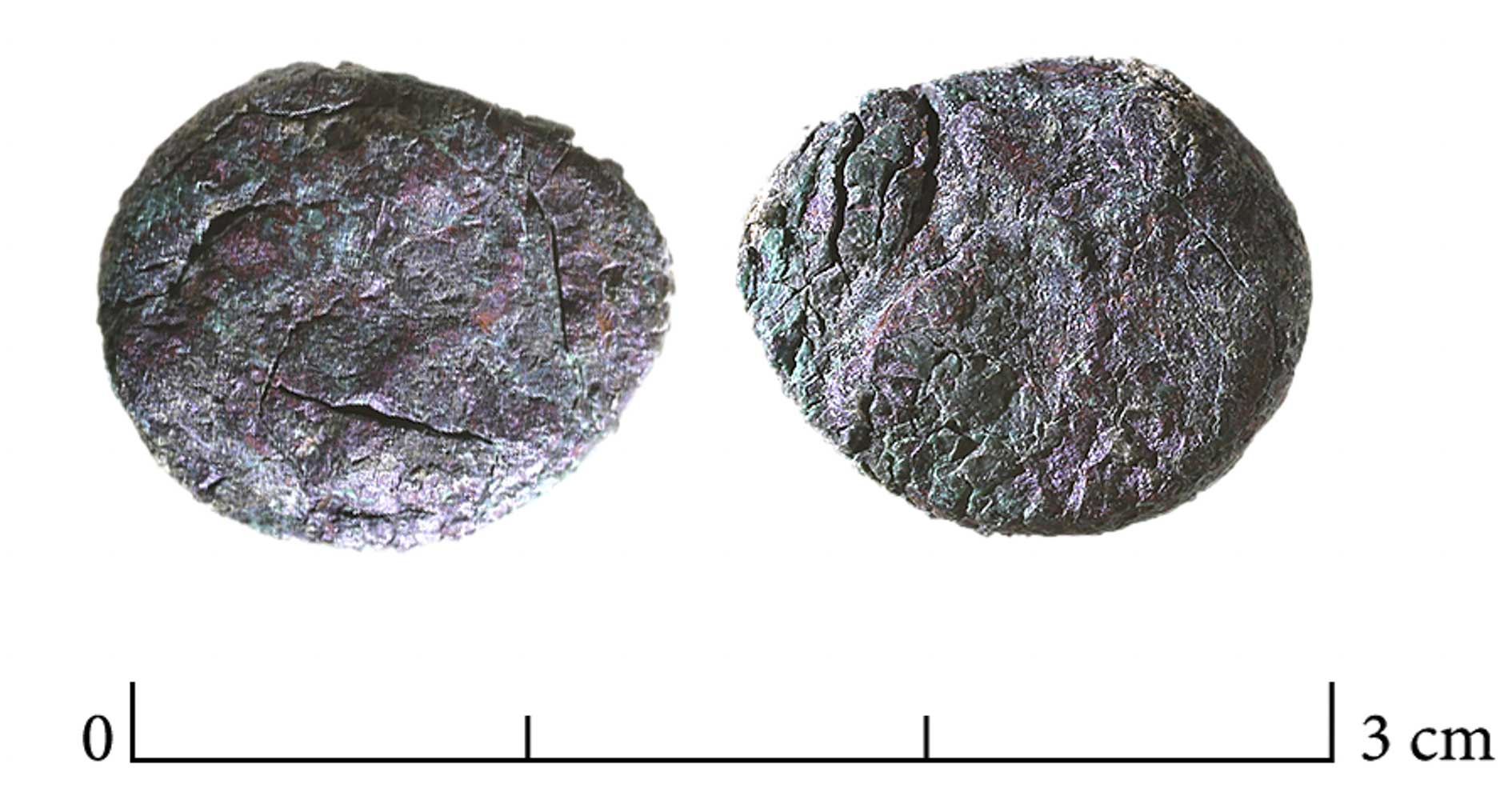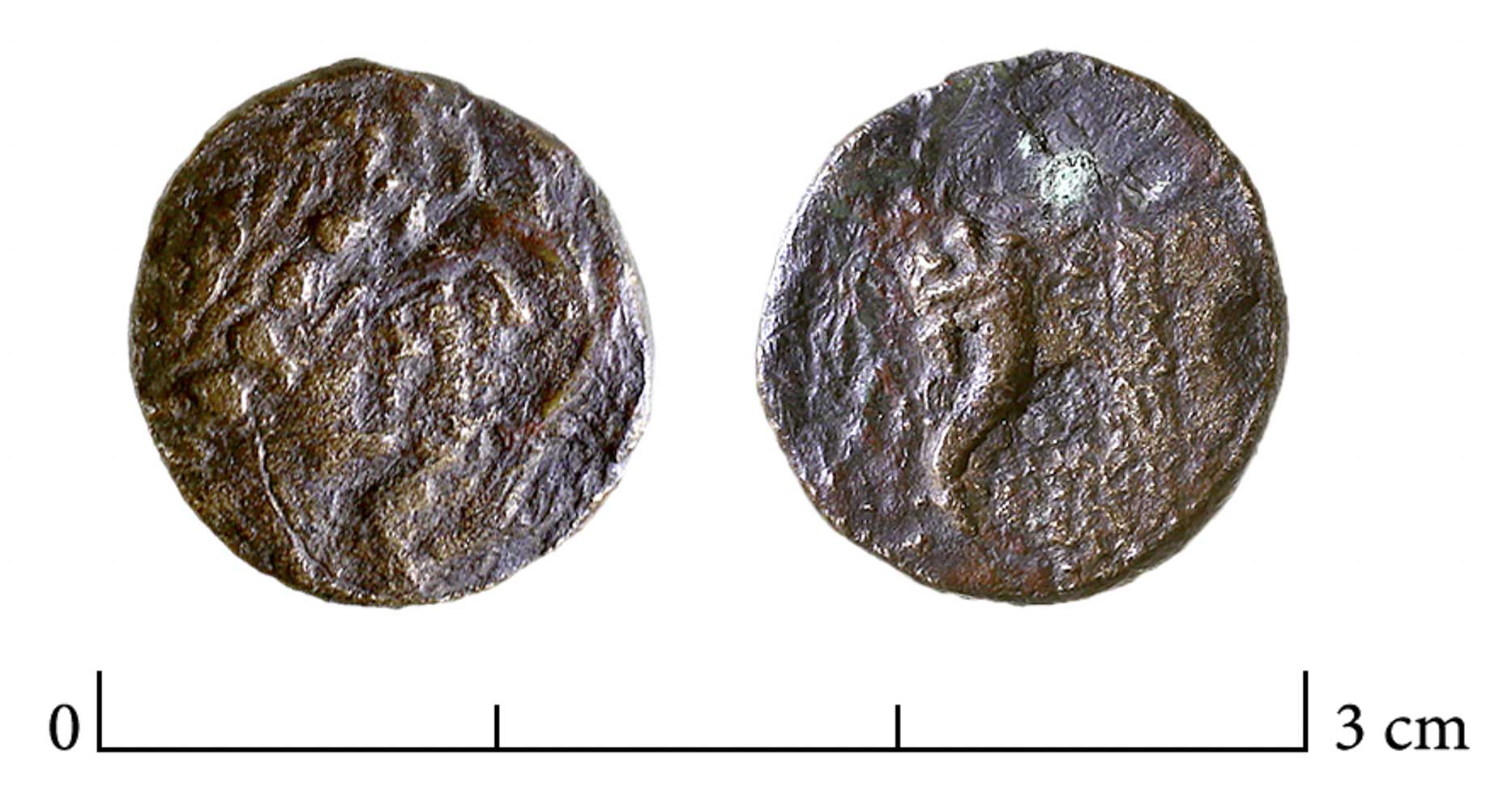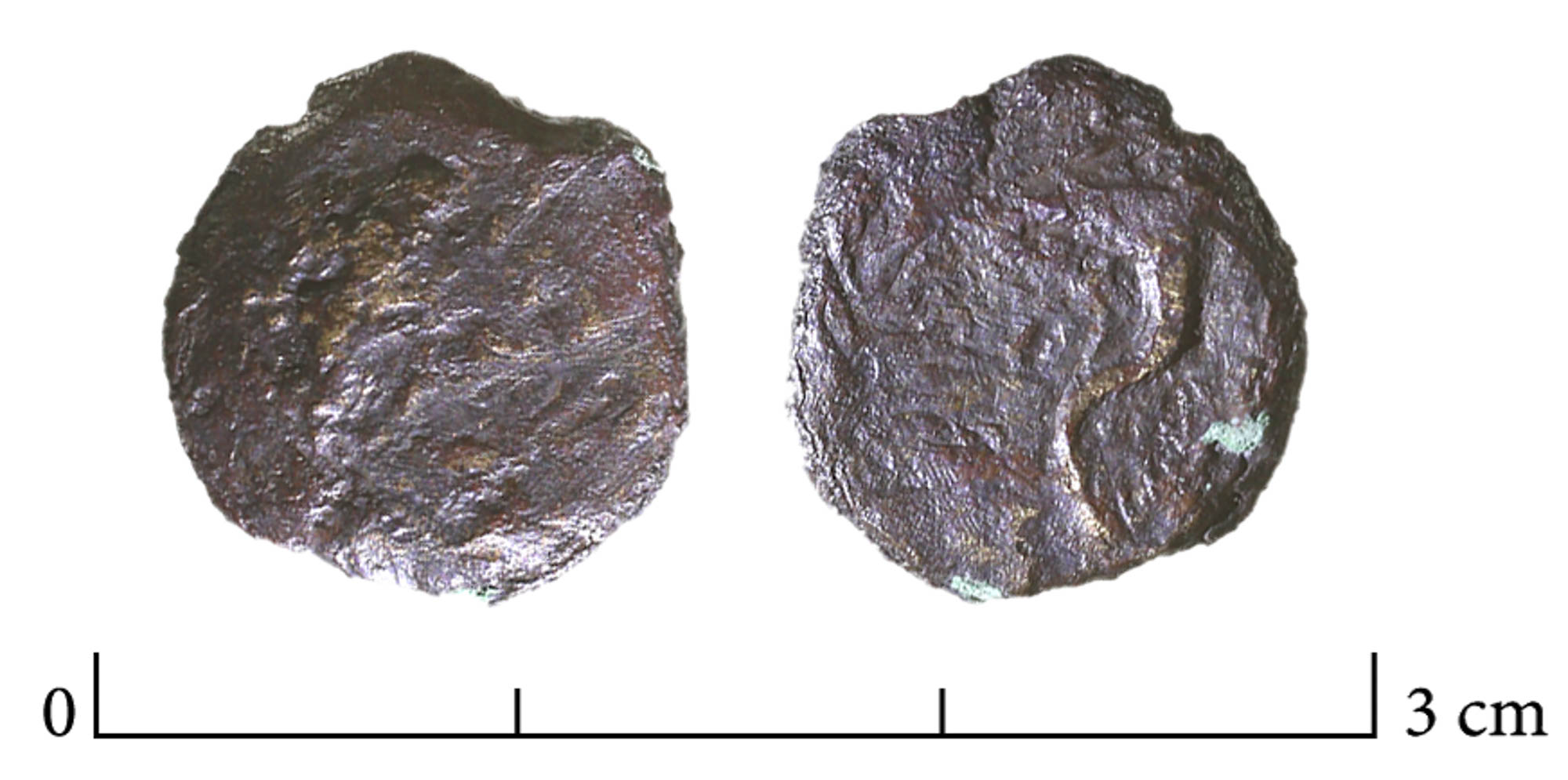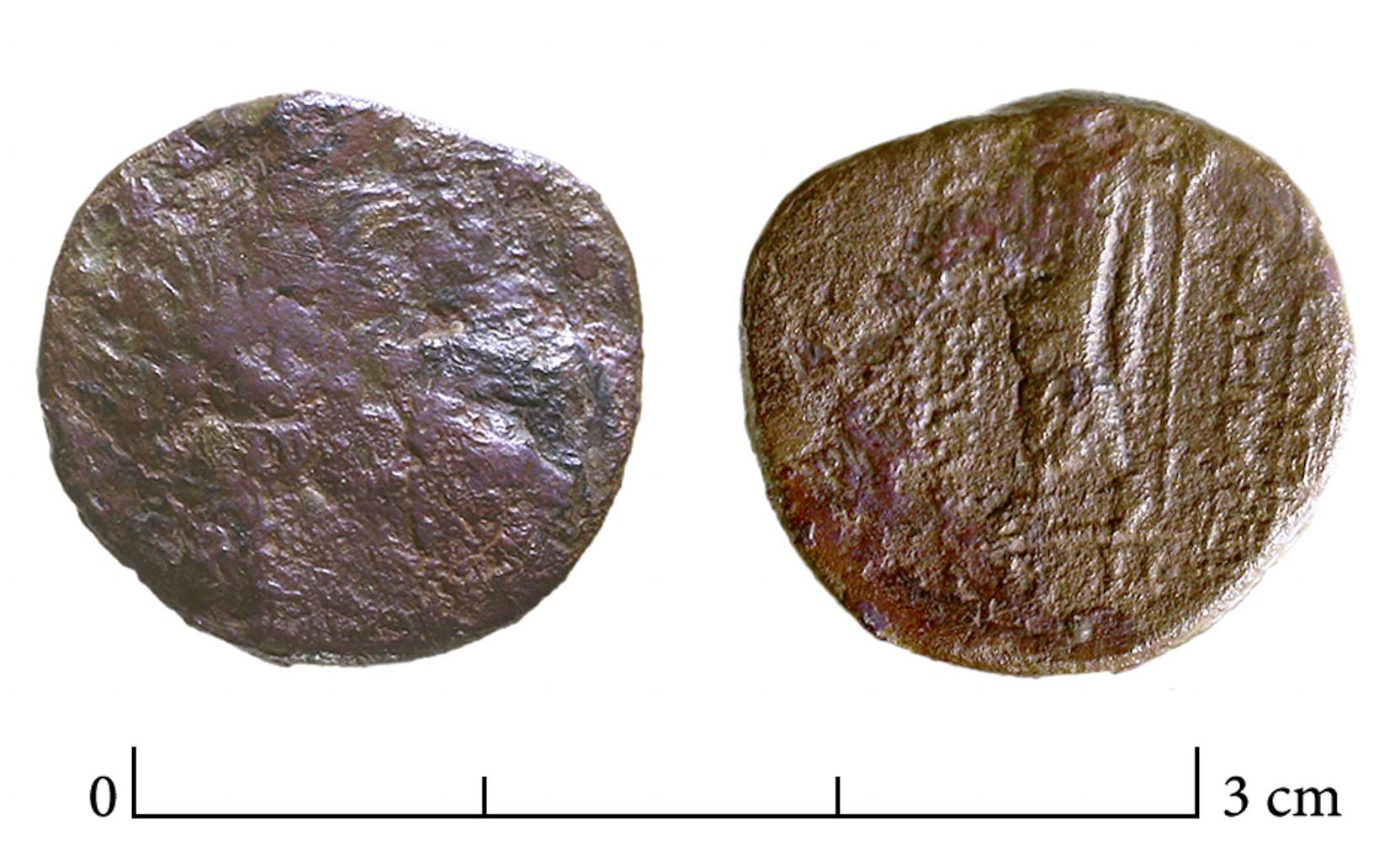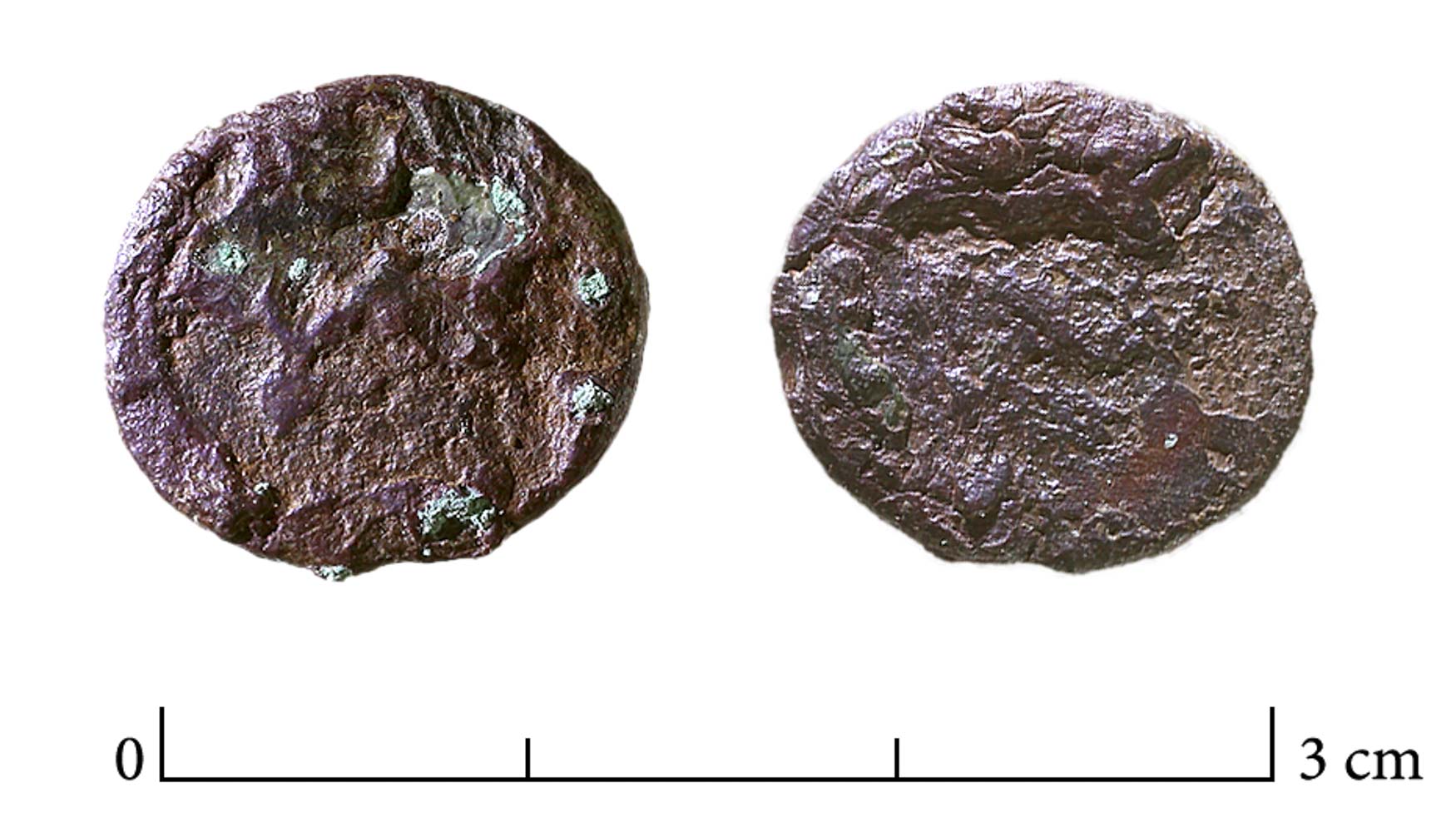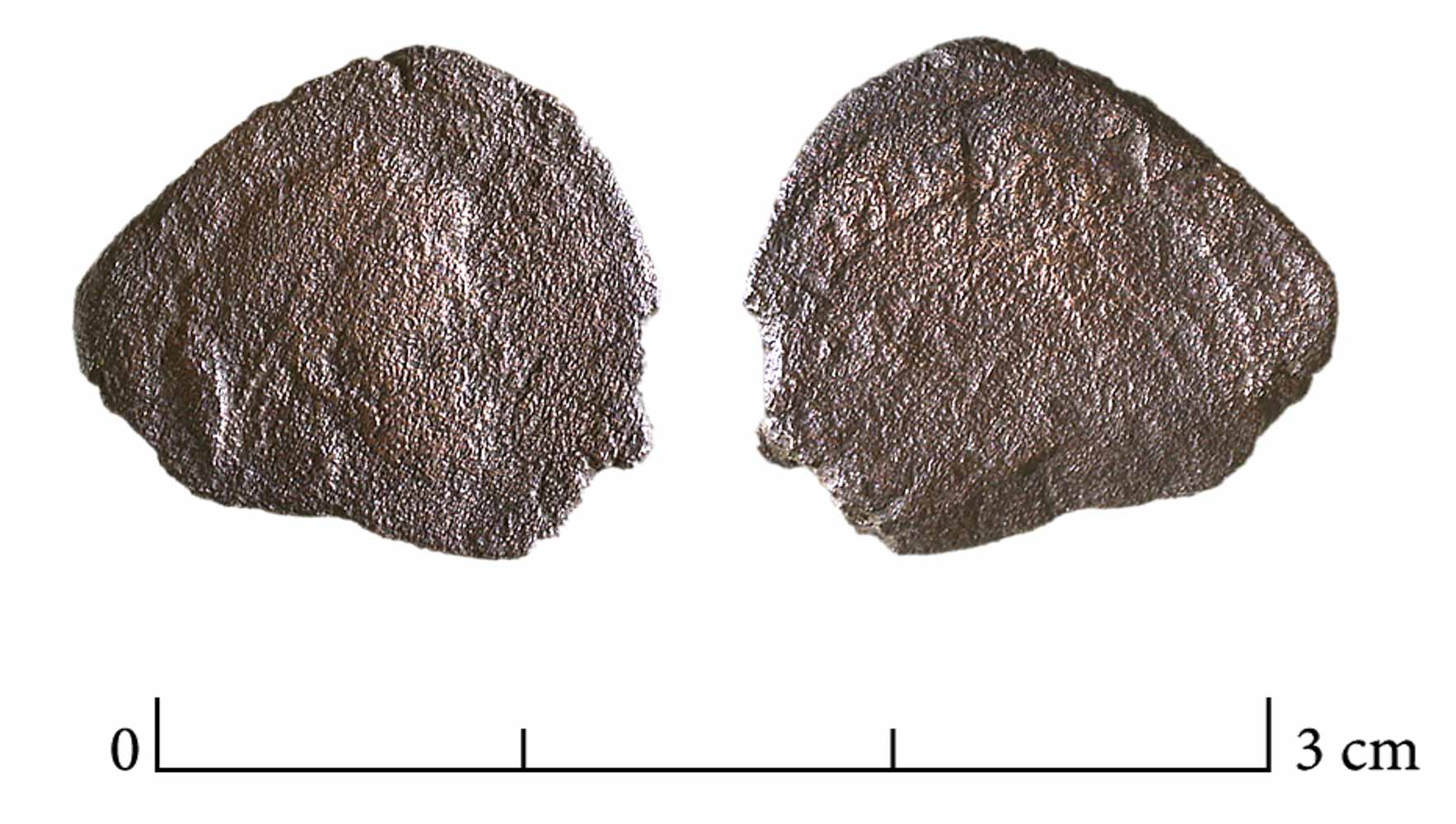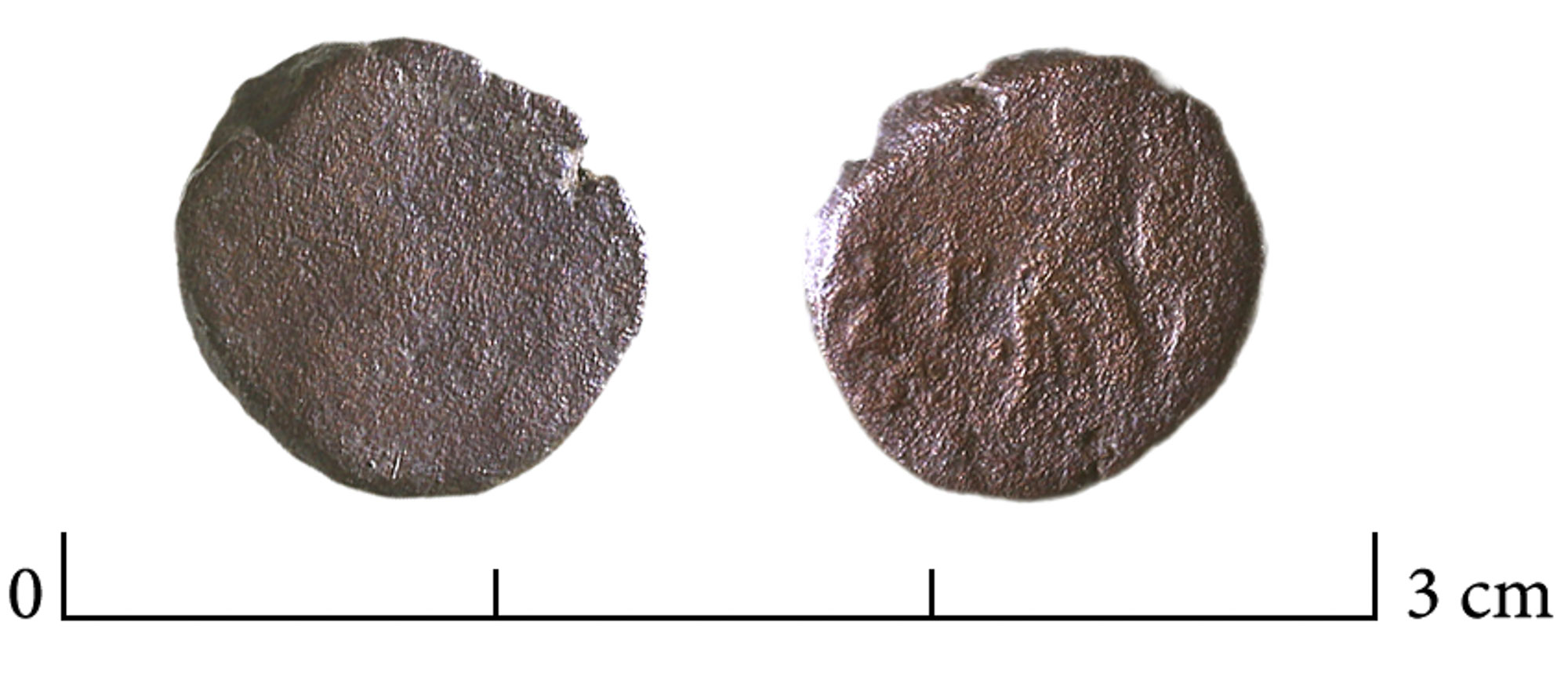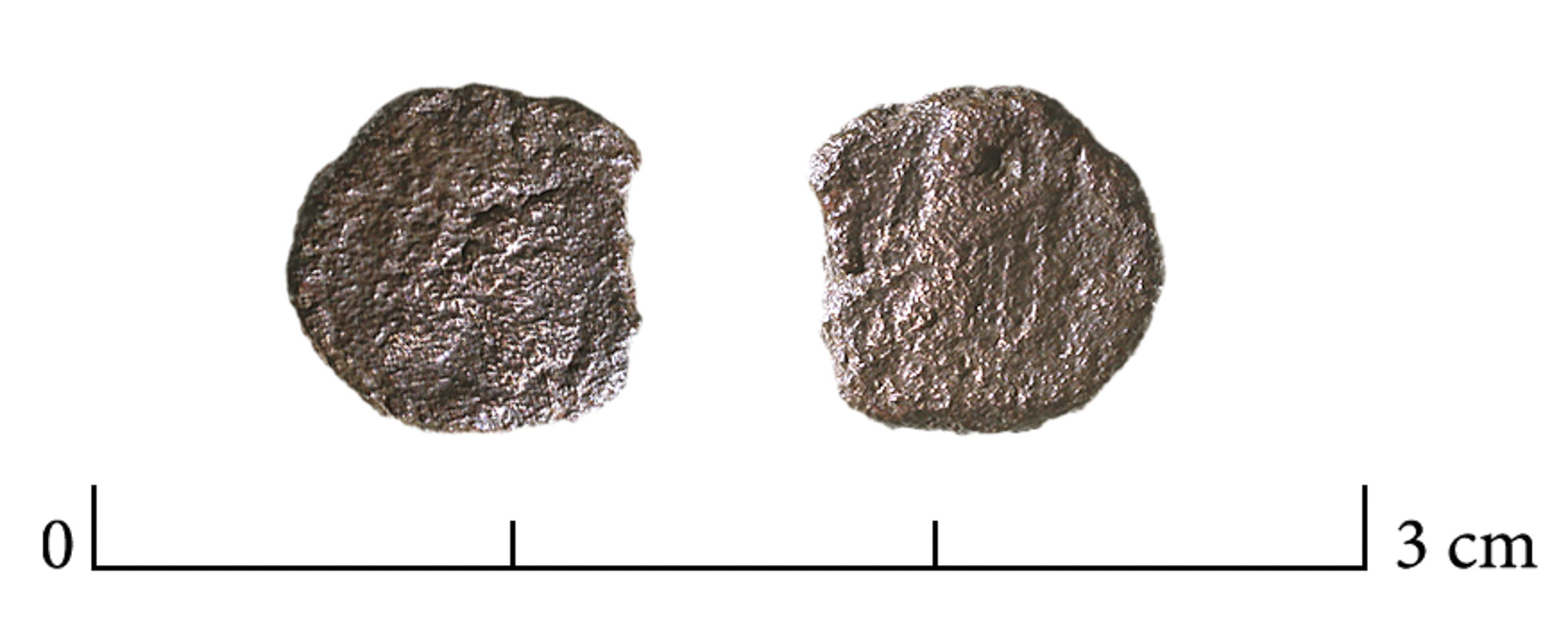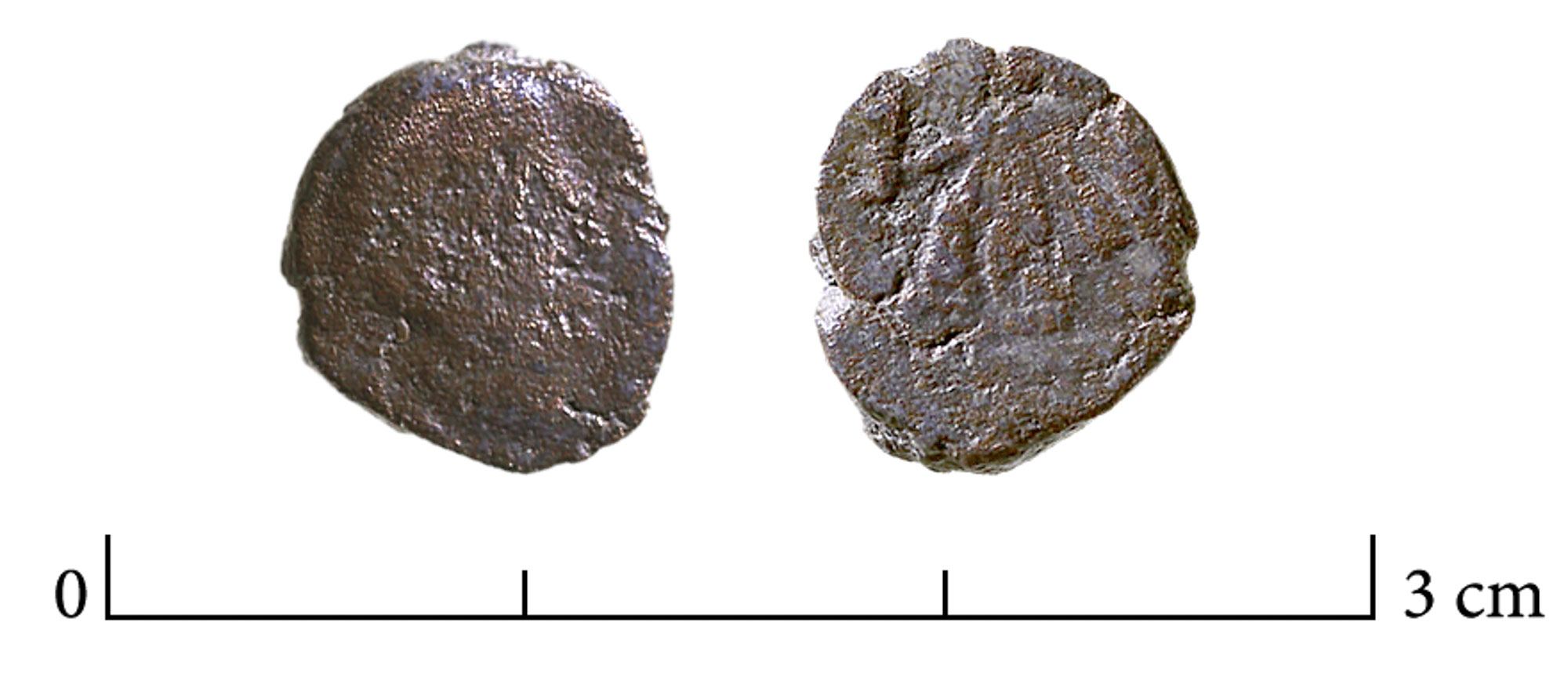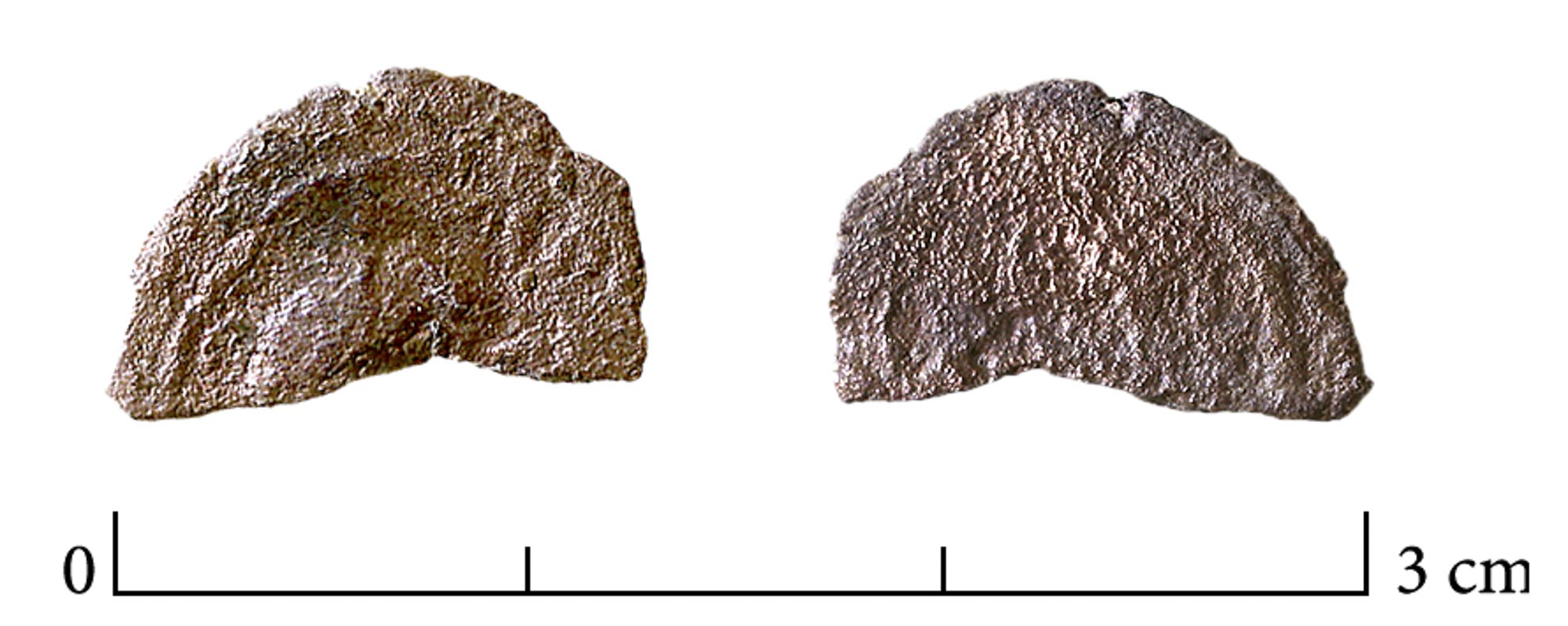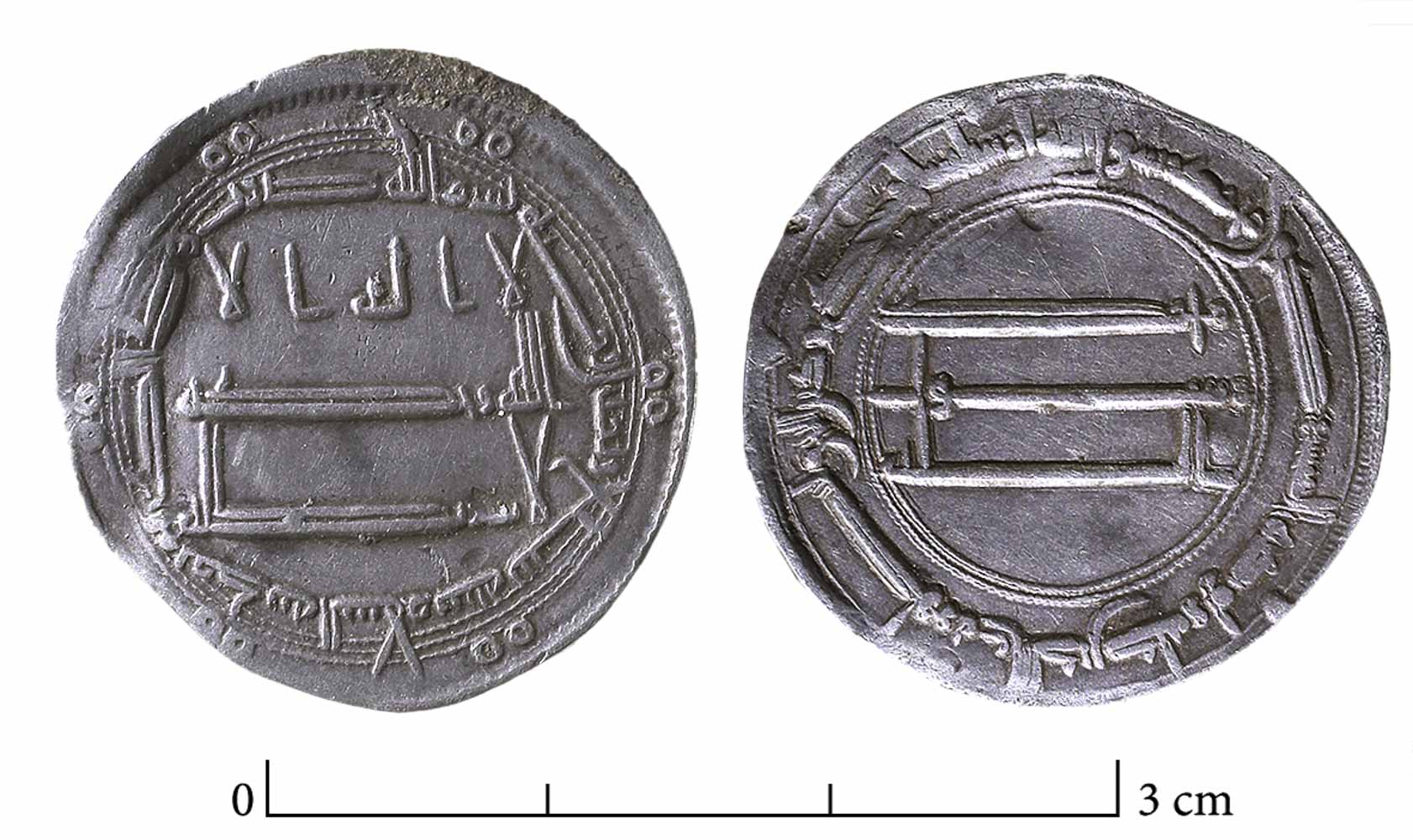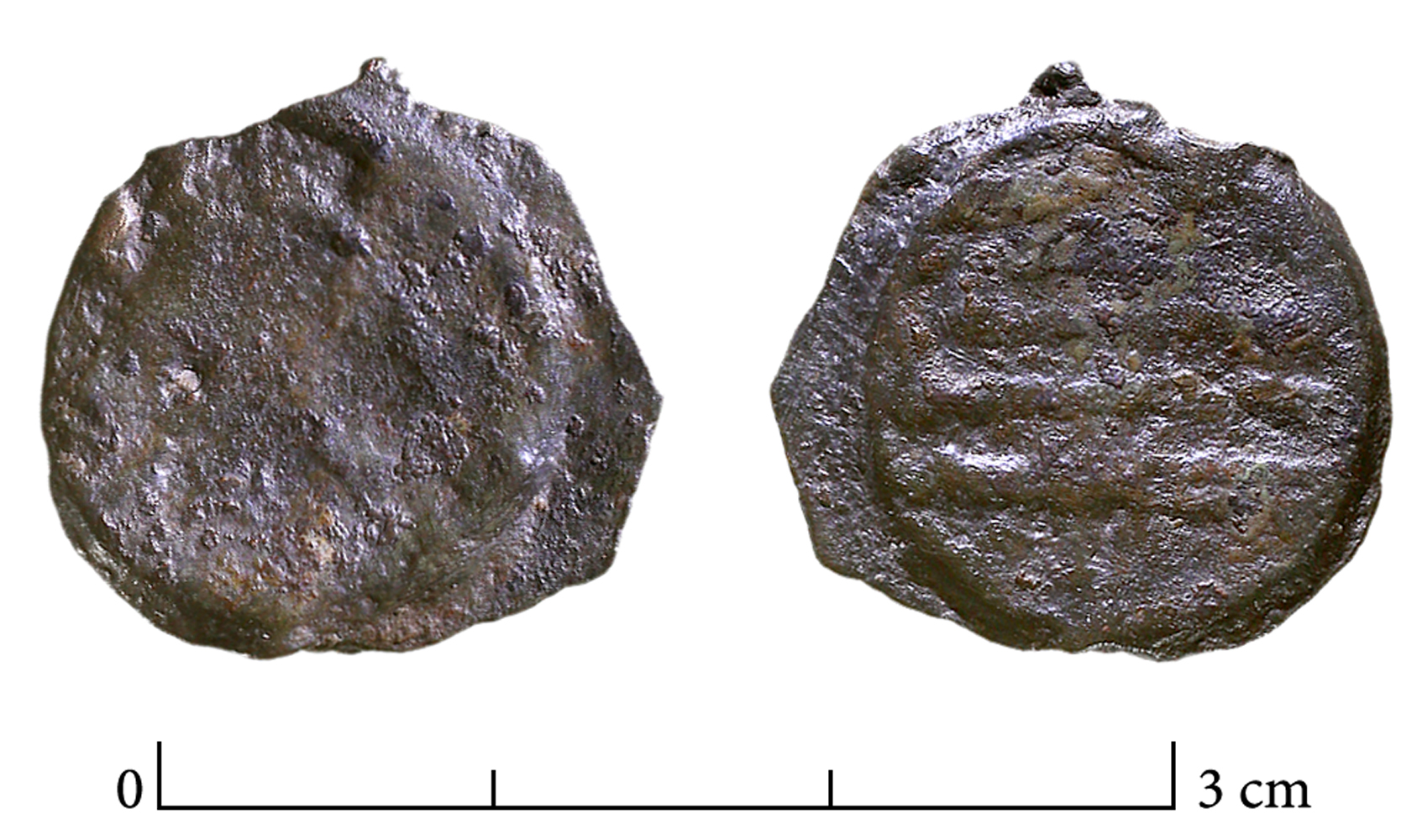The Coins from the 2019 and 2020 Excavation Seasons of the German-Israeli Tell Iẓṭabba Excavation Project
Abstract: This
report catalogues and contextualizes the coin finds from the
2019 and 2020 excavation seasons of the German-Israeli
archaeological project on Tell Iẓṭabba (Beth Shean). The
majority of the coins are Hellenistic and relate to the Seleucid
settlement at the site. Although the sample size is small, it
contributes to our understanding of the overall and turbulent
settlement history.
Keywords:
Coin finds, Seleucids, Tell Iẓṭabba, Nysa-Scythopolis, Beth
Shean
Zusammenfassung: Der Bericht katalogisiert und kontextualisiert die Fundmünzen aus den Grabungskampagnen 2019 und 2020 des deutsch-israelischen archäologischen Projekts auf dem Tell Iẓṭabba (Beth Shean). Der Großteil der Münzen ist hellenistisch und steht in Zusammenhang mit der seleukidischen Besiedlung des Ortes. Obwohl die Gesamtanzahl der Münzen klein ist, trägt sie doch zu unserem Verständnis der Siedlungsgeschichte der Stadt und ihrer turbulenten Geschichte bei.
Schlagwörter: Fundmünzen, Seleukiden, Tell Iẓṭabba, Nysa-Skythopolis, Beth Shean
1. The site and the German-Israeli
project
In 2019 and 2020, a
joint German-Israeli team undertook fieldwork
at Tell Iẓṭabba in
the Beth Shean basin in the western Jordan Valley (Figs 1 and
2). In February 2019 magnetic prospections were carried out
at the site, and in September 2019 and February 2020 excavations
took place in selected areas[1].
Tell Iẓṭabba is the site
of the Seleucid founded settlement of Nysa-Scythopolis. It was
established under King Antiochus IV (in the 160s BCE) and was
destroyed by the Hasmonaean John Hyrcanus in 108/107 BCE[2].
The site seems subsequently to have remained mostly abandoned
until the Late Roman and Byzantine periods, when Christian
buildings and a Samaritan synagogue were erected. The late
Hellenistic and Roman settlement moved further south in the area
of the biblical Tell Beth Shean, where a prosperous city
developed.
The site of Tell Iẓṭabba
has been subject to archaeological exploration since the 1950s.
The most significant fieldwork was undertaken under the aegis of
the Israel Antiquities Authority in the 1990s, when the Late
Antique structures in the western part of Tell Iẓṭabba and the
Seleucid domestic buildings in the eastern part of the mound
were excavated. The results of these excavations are currently
in the process of publication[3].
The new German-Israeli project, directed by the authors, seeks
to achieve a comprehensive understanding of the Seleucid
settlement at Tell Iẓṭabba (East). In the course of our two
seasons of excavations four areas (A‒D) were explored (Fig.
3).
In Area A, mostly
Byzantine remains were found and excavated; while Areas B and C
yielded Hellenistic domestic remains, as did Area D, in which a
significant Byzantine building and a few Roman architectural
remains were also uncovered. In the following, we present a
catalogue of the coins found during the two excavation seasons
and provide a preliminary contextualization. The number of coins
is of course too limited to draw far-reaching conclusions; and,
indeed, the as yet unpublished coin catalogue of the Israel
Antiquities Authority excavations is much larger (numbering
around 450 coins)[4].
However, since the 2019‒2020 excavations funded by the
German-Israeli Foundation constituted only the first phase of a
multi-year project, we present the results of this initial phase
of the project with the purpose of expanding the published
corpus of coin finds. The coins have been identified as follows:
|
Ptolemies |
1 |
|
|
Seleucids |
Total |
22 |
|
|
Seleucus
IV (187–175 BCE) |
1 |
|
Antiochus
IV (175–164 BCE) or Demetrius I (161–150 BCE) |
1 |
|
|
Antiochus
VII (138–129 BCE) |
1 |
|
|
Alexander
II Zabinas (128‒122 BCE) |
4+10
(hoard) |
|
|
Antiochus
VIII (121/0‒97/6 BCE) |
1 |
|
|
Antiochus
IX (114/113‒95 BCE) |
1 |
|
|
Seleucid
unidentified |
3 |
|
|
Civic |
Ptolemais
(Ake) |
4 |
|
Hellenistic
unidentified |
2 |
|
|
Late
Roman and Byzantine |
6 |
|
|
Abbasids |
2 |
|
|
Total |
27+10
(hoard) |
|
2. Hellenistic occupation and coins
The Hellenistic coins
from the German-Israeli Tell Iẓṭabba excavations mostly belong
to 2nd-century BCE Seleucid bronze currency. This
accords with the assumed foundation of the Seleucid settlement
under Antiochus IV. Most of the coins originate from Seleucid
domestic strata. A few earlier coins, from Seleucus IV and the
Ptolemies, possibly relate to older currency that was still in
circulation. A similar situation is encountered at neighboring
trans-Jordanian sites. These include Gerasa of the Decapolis,
established at the same time as Nysa (Tell Iẓṭabba), where some
older Ptolemaic coins were found[5];
Decapolitan Gadara, where some Ptolemaic coins were excavated,
although the majority of the Hellenistic material is from the
post-Antiochus IV period[6];
and Pella, another neighboring center of the Decapolis with an
analogous foundation history and featuring a similar
distribution of Hellenistic coin finds[7].
There are, however, also differences. One notable
difference is that of the comparatively large number of coins of
Alexander II Zabinas found at Tell Iẓṭabba, and for which the
coin hoard – not included in this report – still needs to be
counted. However, this high proportion of coins from Alexander
II Zabinas has been dealt with elsewhere[8].
Another apparent difference to the coins found in the
aforementioned Decapolis cities, is the termination of Seleucid
coins under Antiochus IX at Tell Iẓṭabba following the Hasmonean
destruction. The latest coin found in the German-Israeli
excavations dates to 111/110 BCE, shortly before the destruction
of the settlement by John Hyrcanus in 108/107 BCE. Although the
capture of the city is reported by Josephus in Ant. 13,280 (see
also War 1,66), the absolute date for the site’s destruction
comes from the evidence of the Rhodian stamped handles retrieved
from the site. Prior to our own expedition three other
excavations had been carried out at the site, yielding a total
of over 360 stamps, with the majority being Rhodian. The latest
Rhodian stamp recovered from the site is related to the latest
eponym of Period V, namely 108 BCE[9].
This evidence would seem to coincide with the latest coins
recovered during the Israel Antiquities Authority excavations
(R. Bar-Nathan and G. Mazor): namely, Antiochus IX coins, of
SC’s 2388 type
(below cat. no. 10), which are known from the Seleucid era 201,
202 and 204 (= 108/107 BCE), in contrast to the total absence of
coins from Antiochus VIII’s third reign in Antioch (109–96 BCE)[10].
Noteworthy among the Hellenistic coins are the four civic
coins from Ptolemais (Ake). In neighboring Pella, too, the
Hellenistic civic coins are predominantly from Ptolemais[11],
suggesting direct trade links between Pella and this
Mediterranean harbor city, which was easily accessible via the
Jezreel Valley. Civic coins from Ptolemais have also been found
in Gerasa, as have coins from other Phoenician cities such as
Tyre[12].
3. Late Roman and Byzantine occupation
and coins
The gap in coin finds
between Antiochus IX and the Late Roman period matches what is
known archaeologically to date about Tell Iẓṭabba. In the Roman
period, this area was not part of the rebuilt Greco-Roman city
but was occupied by necropoleis[13].
To date, no tombs have been found in the plateau’s eastern part
of Tell Iẓṭabba, where the German-Israeli excavations were
carried out, suggesting that there was little Roman occupation
in this area. However, this assumption should be treated with
caution, as during our 2020 excavations we also reached possible
Roman strata[14].
In Area D, the German-Israeli Tell Iẓṭabba Excavation
Project unearthed Late Roman and Byzantine structures[15],
and although the nature of these structures has not yet been
determined with certainty, they seem to have been related to the
ecclesiastical and monastic buildings uncovered in the western
part of the mound, as well as to construction of the
Byzantine-period fortifications that cross Tell Iẓṭabba from
east to west.
4. Early Islamic coins
The absence of Umayyad
coin finds during the German-Israeli Tell Iẓṭabba Excavation
Project is noteworthy. This might suggest that the area was at
least partly abandoned in the Late Byzantine period and before
the earthquake of 749 CE[16].
It can be assumed that the Islamic conquest of the region may
have led to a decline in ecclesiastical and monastic activity in
this area, but also the transfer of the provincial capital of
Jund al-Urdunn to Tiberias probably contributed to a significant
loss in importance. The splendid Abbasid dirham of 804 CE and
the unidentified Abbasid bronze coin, found at the site, do
little to alter this picture of sparse early Islamic activity,
since it is an isolated find and belongs to the post-749 CE
occupation of the Beth Shean area.
5. Conclusions
In the above we have
provided a few preliminary observations on the site’s
occupational history via its coin finds. Future publications and
excavations are expected to further enhance our understanding of
the site’s occupational history through its material culture.
The German-Israeli Tell Iẓṭabba Excavation Project is currently
an ongoing research project; and we intend to continue
excavations at the site in order to gain a better understanding
of its economic basis and cultural interactions with other
Mediterranean centers during its periods of successive
occupation.
6. Catalogue of the coins
Ptolemies
Cat. no. 1)
Area B
L233; B2180 (IAA no.
178560) (Fig. 4)
Ptolemy II Philadelphus
(283/2–246 BCE), hemiobol, reformed coinage, c. 265–261/0 BCE;
beveled flan; central cavities
Obv. Horned head of
Zeus-Ammon r.
Rev. [BΑΣΙΛΕΩΣ
ΠΤΟΛΕΜΑΙΟΥ], eagle standing on thunderbolt to l.; spread wings;
control between eagle’s legs
Æ, Æ19 mm, 4.84 g; axis
12
Ref.
CPE Part
I.2, 57, no. B239 (Θ between eagle’s legs) or
59, no.
B260 (O between eagle’s legs)
Seleucids
Seleucus IV
(187–175 BCE)
Cat. no. 2)
Area B
L235; B2185 (IAA no.
178561) (Fig. 5)
Seleucus IV Philopator,
Antioch (187–175 BCE); serrated flan
Obv. Laureate head of
Apollo r.; illegible monogram on l. field
Rev. ΒΑΣΙΛΕΩΣ ΣΕΛΕΥΚΟΥ,
Apollo standing l., holding arrow, leaning on tripod;
Primary
control on l. field;
secondary control below it;
central cavity
Æ, Æ22 mm,
9.07 gr; axis 12
Antiochus IV
(175–164 BCE) or Demetrius I (161–150
BCE)
Cat. no. 3)
Area B
L205; B2055 (IAA no.
178549) (Fig. 6)
Antiochus IV Epiphanes
or Demetrius I Soter, Tyre; beveled flan
Obv. Head of Antiochus
IV r., diademed; central cavity
Rev. […] (curving) r.,
[…] (curving) l., Palm tree
Æ, Æ15 mm, 2.72 g; axis
12
Ref.
SC II, 85, no. 1462
or
SC II, 180, no. 1676; see also Syon 2014, 128, table 5.23; cf.
nos. 208‒233
Antiochus VII
(139/138–130/129 BCE)
Cat. no. 4)
Area B
L211; B2089 (IAA no.
178555) (Fig. 7)
Antiochus VII Euergetes
[Sidetes], Antioch (139/8–130/129 BCE)
Obv. Lion head r.,
dotted border
Rev. [Β]ΑΣΙΛΕΩΣ ΑNTIOXOΥ
in two lines, ΕΥΕΡΓΕΤΟΥ on l., vertical club; below (worn) date;
control mark on outer l. field ligatured ΔI above
an uncertain symbol
Æ, Æ15 mm, 2.23 g; axis
12
Alexander II Zabinas
(129/8–122 BCE)
Cat. no. 5)
Area B
L201; B2006 (IAA no.
178544) (Fig. 8)
Alexander II Zabinas,
Antioch (129/8–126/5 BCE); beveled flan
Obv. Head of Alexander
II Zabinas r., diademed; fillet border
Rev. ΒΑΣΙΛΕ[ΩΣ] /
ΑΛΕ[ΞΑΝΔΡΟΥ]; Dionysus standing l. holding thyrsus
Æ, Æ21 mm, 6.48 g; axis
12
Ref. Cf.
SC II, 453–454, no. 2229
Cat. no. 6)
Area B
L205; B2052 (IAA no.
178548) (Fig. 9)
Alexander II Zabinas,
Antioch (125‒122 BCE); beveled flan
Obv. Head of Alexander
II r., diademed; circular border
Rev. [ΒΑΣΙΛΕΩΣ
ΑΛΕΞΑΝΔΡΟΥ] in two lines; two filleted cornucopiae, splayed and
intertwined. In r., field, Σ; in l. field, A
Æ, Æ20 mm, 6.95 g; axis
11
Ref.
SC II, 456, no. 2235.1e‒1f
Cat. no. 7)
Area B
L209; B2090 (IAA no.
178551) (Fig. 10)
Alexander II Zabinas;
serrated flan; perhaps Apameia on the Orontes (129/8–122 BCE),
however see comments in SC II, p. 459 regarding this
attribution.
Obv. Head of young
Dionysus r., wreath with ivy, dotted border
Rev. [ΒΑΣΙΛΕΩΣ on r.,
ΑΛΕΞΑΝΔΡΟΥ on l.,] winged Tyche standing l., calathus on head,
holding ship’s tiller and cornucopia
Æ, Æ19 mm, 5.42 g; axis
12
Cat. no. 8)
Area C
L357; B3269 (IAA no.
178562) (Fig. 11)
Alexander II Zabinas;
serrated flan; perhaps Apameia on the Orontes (129/8–122 BCE),
however see comments in SC II, p. 459 regarding this
attribution.
Obv. Head of young
Dionysus r., wreath with ivy, dotted border
Rev. [Β]ΑΣΙΛΕΩAΣ on r.,
[ΑΛΕΞΑΝΔΡΟΥ] on l., winged Tyche standing l., calathus on head,
holding ship’s tiller and cornucopia
Æ, Æ19 mm, 5.19 g; axis
12
Antiochus VIII
(121/0‒97/6 BCE)
Cat. no. 9)
Area B
L209; B2088 (IAA no.
178550) (Fig. 12)
Antiochus VIII, Antioch
(121/0‒114/3 BCE)
Obv. Head of Antiochus
VIII r., diademed and radiate
Rev.
ΒΑΣΙΛ[ΕΩΣ/ΑNTIOXOΥ]; on r.; [EΠIΦANOYΣ] on l. Eagle with closed
wings stg. l.
Æ, Æ19 mm, 4.23 g; axis
12
Antiochus IX
(114/113‒95 BCE)
Cat. no. 10)
Area D
L478; B4423 (IAA no.
178565) (Fig. 13)
Antiochus IX Philopator;
beveled flan; mint, probably in Phoenicia (111/110 BCE).
Obv. Bust of winged Eros
r.; dotted border
Rev. [ΒΑΣΙΛΕΩΣ ΑΝΤΙΟΧΟΥ]
in two lines on r., ΦΙΛΟΠΑΤΟΡΟΣ on l.; Nike advancing l.,
holding wreath. In l., field, date, ΒΣ (202 = 111/110 BCE)
Æ, Æ19 mm, 3.99 g; axis
12
Seleucids unidentified
Cat. no. 11)
Area B
L233; B2179 (IAA no.
178559) (Fig. 14)
Swollen flan (4 mm)
Obv. Head of a Seleucid
king r.
Rev. Worn
Æ, Æ15 mm, 2.93 g
Cat. no. 12)
Area B
L202; B2011 (IAA no.
178545) (Fig. 15)
Obv. Worn
Rev. Worn
Æ, Æ20 mm, 4.64 g
Cat. no. 13)
Area B
L232; B2189 (IAA no.
178558) (Fig. 16)
Swollen flan (4 mm)
Obv. Worn
Rev. Worn
Æ, Æ15 mm, 1.92 g
Civic
Cat. no. 14)
Area B
L209; B2110 (IAA no.
178553) (Fig. 17)
Ptolemais (Ake), 169‒164
BCE(?)
Obv. Jugate busts of the
Dioscuri r.
Rev.
[ΑΝΤΙΟΧΕΩΝ/ΤΩΝ/ΕΝ/ΠΤΟΛΕΜΑΙΔΙ]; cornucopia; in l. field, Α
Æ, Æ14 mm, 2.01 g; axis
12
Ref. Cf. CHL 8, nos.
68–74
Cat. no. 15)
Area C
L338; B3297 (IAA no.
178564) (Fig. 18)
Ptolemais (Ake), 169‒164
BCE(?)
Obv. Jugate busts of the
Dioscuri r.
Rev.
[ΑΝΤΙΟΧΕΩΝ/ΤΩΝ/ΕΝ/ΠΤΟΛΕΜΑΙΔΙ];
cornucopia
Æ, Æ13 mm, 1.21 g; axis
12
Ref. Cf. CHL 8, nos.
68–74
Cat. no. 16)
Area B
L202; B2013 (IAA no.
178546) (Fig. 19)
Ptolemais (Ake), ca.
164–133 BCE
Obv. Head of Zeus r., laureate
Rev. [ANTIOXEΩ]N T[ΩN] /
EN ΠΤΟΛΕΜ[AIΔI] / IEPAΣ AΣ[YΛOY]; Zeus standing l., holding ears
of grain in r. and scepter in l.
Æ, Æ18 mm, 3.32 g; axis
12
Ref. Kadman 1961,
102–103, nos. 55–58
Cat. no. 17)
Area B
L203; B2023 (IAA no.
178547) (Fig. 20)
Ptolemais (Ake), ca.
164–133 BCE
Obv. Head of Zeus r.,
laureate
Rev. [ANTIOX]EΩ[N TΩN /
EN ΠΤΟ]ΛΕΜ[AIΔI] / IEPAΣ AΣ[YΛOY]; Zeus standing l., holding
ears of grain in r. and scepter in l.
Æ, Æ19 mm, 2.39 g; axis
12
Ref. Kadman 1961,
102–103, nos. 55–58
Hellenistic unidentified
Cat. no.
18) Area B
L209; B2111 (IAA no.
178554) (Fig. 21)
Obv. Worn
Rev. Worn
Æ, Æ15 mm, 1.96 g
Cat. no. 19)
Area B
L209; B2094 (IAA no.
178552) (Fig. 22)
Obv. Worn
Rev. Worn; corroded
surface
Æ, Æ11 mm, 1.34 g
Late Roman and Byzantine
Constantius II
(351–361 CE)
Cat. no. 20)
Area B
L232; B2175 (IAA no.
178556) (Fig. 23)
Broken
Obv. [D N CONSTANTIVS] P
F AVG; draped and cuirassed bust of Constantius II r.
Rev. [FEL TEMP
RE]PARATIO; soldier spearing fallen horseman l.
Æ,
Æ17 mm,
1.79 g; axis 12
Theodosius I
(379-395 CE) /
Arcadius (383-408
CE)
Cat. no. 21)
Area A
L101; B1018 (IAA no.
178539) (Fig. 24)
Uncertain mint, Nummus.
Obv. Remnants of draped
and cuirassed bust
Rev. SAL[VS REI
PVBLICAE]; Victory advancing l. dragging captive, in field l. ☧
Æ, Æ13 mm, 1.16 g; axis
12
Unidentified
Cat. no. 22)
Area A
L103; B1016 (IAA no.
178540) (Fig. 25)
Late Roman-Byzantine?
Obv. Head r.
Rev. Standing figure
Æ, Æ9 mm, 0.72 g
Cat. no. 23)
Area B
L201; B2002 (IAA no.
178543) (Fig. 26)
Late Roman-Byzantine
Obv. Bust r.
Rev. Nike, holding
wreath(?)
Æ, Æ11 mm, 0.96 g
Cat. no. 24)
Area B
L232; B2178 (IAA no.
178557) (Fig. 27)
Broken
Obv. Bust r.
Rev. Helmeted soldier?
Æ, Æ17 mm, 0.84 g; axis
12
Cat. no. 25)
Area A
L103; B1017 (IAA no.
178541) (Fig. 28)
Byzantine?
Broken
Obv. Worn
Rev. Worn
Æ, Æ14 mm, 0.35 g
Abbasids
Cat. no. 26)
Area C
L332, B3161 (IAA no.
178563) (Fig. 29)
Harun al-Rashid (786‒809
CE), Medinat al-Salam, 187 AH (= 802/3 CE)
Obv. Center:
لا اله الا الله وحده لا شرك
له
(There is no deity
except | God. He is alone | He has no equal);
margin:
بسم الله ضرب هذا الدرهم بمدينة
السلام سنة سبع و تمنين و مئة
(In the name of Allah,
this dirham was struck at Madinat al-Salam year seven and eighty
and one hundred)
Rev. Center:
محمد رسول الله
(Muhammad | is the
messenger of | God);
margin:
محمد رسول الله ارسله بالهدى و دين
الحق ليظهره على الدين كله و لو كره المشركون
(Muhammad is the
messenger of Allah, he has sent him with the guidance and the
religion of truth to proclaim it over all religion even if the
polytheists detest it)
Silver dirham,
Æ24 mm, 2.94 g; axis 6
Ref. Savage 1999, 171
no. 1374
Cat. no. 27)
Area A
L103; B1024 (IAA no.
178542) (Fig. 30)
Presumably northern Syria,
Jazira, al-Raqqa, 183 AH (= 799/800
CE)
Obv. Worn
Rev. Worn; three lines
of illegible Arabic inscription, pentagram above
Æ, Fals,
cast, Æ19 mm, 2.48 g
Ref. Heidemann 2003,
118–120
Photo credit:
All photographs © German-Israeli Tell Iẓṭabba Excavation Project
[1] The
excavations form part of a German-Israeli research
project ‘Tell Iẓṭabba (Nysa-Scythopolis):
High-resolution Hellenistic Settlement Archaeology and
the Reassessment of the Formation of the Decapolis,
mainly funded by the German-Israeli Foundation for
Scientific Research and Development (GIF Regular Program
[grant I-150-108.7-2017]), to which we are grateful. The
project was licensed by the Israel Antiquities Authority
(G-70/2019; G-17/2020) and the Israel Nature and Parks
Authority (A-014/19; A-020/20). We thank Diana Medellin
Martinez (Laboratory for Conservation of Metallic
Artifacts of the Institute of Archaeology of Tel Aviv
University) for cleaning the coins, as well as Stefan Heidemann, Cathy Lorber and Danny Syon for commenting on
selected coins, and Yoav Farhi for reviewing an earlier
version of the manuscript. Thanks also go to Donald T.
Ariel for helpful comments and registering the coins at
the Israel Antiquities Authority. For
project reports cf. Ebeling – Edrey – Harpak –
Lichtenberger – Tal 2019; 2020; Lichtenberger – Meyer –
Tal 2020; Orendi – Lichtenberger – Tal 2021; Jackson-Tal
– Lichtenberger – Tal 2021.
[2] For
an historical overview of Hellenistic Nysa-Scythopolis
and a research history of the site cf. the above-noted
project’s reports, with further bibliography.
[3] See
Mazor – Atrash – Finkielsztejn 2018.
[4] The
coins will be published by Yoav Farhi, Jerusalem (Farhi
Forthcoming).
[5] Lichtenberger – Raja
2020, 379.
[6] Noeske 2013, 139.
[7] Sheedy – Carson –
Walmsley 2001, 6.
[8] Lichtenberger – Tal
2020. For the textile remains
attached to the coins from the hoard cf. Shamir –
Lichtenberger – Tal 2021.
[9] Mazor
– Atrash – Finkielsztejn 2018, 19.
[10] G.
Mazor, Y. Farhi, pers. comm.
[11] Sheedy – Carson –
Walmsley 2001, 6.
[12] Lichtenberger – Raja
2020, 379.
[13] NEAEHL, s.v. Beit
Shean.
[14] Ebeling – Edrey –
Harpak – Lichtenberger – Tal 2020.
[15] Ebeling – Edrey –
Harpak – Lichtenberger – Tal 2019; Ebeling – Edrey –
Harpak – Lichtenberger – Tal 2020.
[16] On
Beth Shean in the Early Islamic period and its loss in
importance cf. Tsafrir – Foerster 1997, 135–146 (p. 140
on the abandonment of Tell Iẓṭabba).
